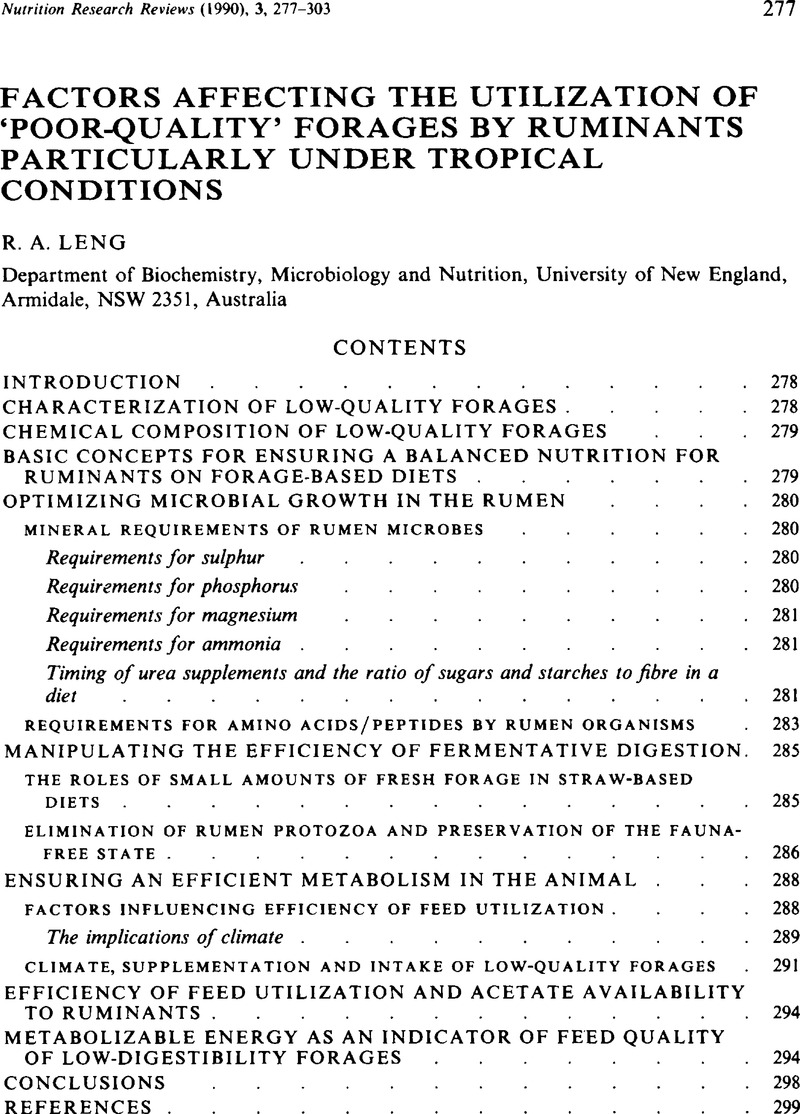Crossref Citations
This article has been cited by the following publications. This list is generated based on data provided by Crossref.
Pathak, A. K.
Dutta, Narayan
Banerjee, P. S.
Pattanaik, A. K.
and
Sharma, K.
1970.
Influence of Dietary Supplementation of Condensed Tannins through Leaf Meal Mixture on Intake, Nutrient Utilization and Performance of Haemonchus contortus Infected Sheep.
Asian-Australasian Journal of Animal Sciences,
Vol. 26,
Issue. 10,
p.
1446.
Badamana, M. S.
and
Sutton, J. D.
1992.
Hay intake, milk production and rumen fermentation in British Saanen goats given concentrates varying widely in protein concentration.
Animal Science,
Vol. 54,
Issue. 3,
p.
395.
Stevani, J.
Durand, M.
Zanchi, R.
Beaumatin, Ph.
and
Hannequart, G.
1992.
Effects of sulphate supplementation of untreated and alkali-treated wheat straws on ruminal fermentation and microbial protein synthesis in a semi-continuous fermentor.
Animal Feed Science and Technology,
Vol. 36,
Issue. 3-4,
p.
287.
van Houtert, M.F.J.
1993.
The production and metabolism of volatile fatty acids by ruminants fed roughages: A review.
Animal Feed Science and Technology,
Vol. 43,
Issue. 3-4,
p.
189.
Combellas, J.
Priore, F.
Peralta, J.
and
Zavarce, O.
1993.
Influence of the addition of fish meal to diets of roughage or roughage and concentrate on the consumption and live-weight gain of growing cattle.
Animal Feed Science and Technology,
Vol. 42,
Issue. 3-4,
p.
319.
1993.
Abstracts of Communications.
Proceedings of the Nutrition Society,
Vol. 52,
Issue. 1,
p.
1A.
Schiere, J.B.
and
de Wit, J.
1993.
Feeding standards and feeding systems.
Animal Feed Science and Technology,
Vol. 43,
Issue. 1-2,
p.
121.
Kouakou, B.
Goetsch, A. L.
Patil, A. R.
Galloway, D. L.
Johnson, Z.B.
and
Park, K.K.
1994.
Voluntary intake and digestibility by mature beef cattle and holstein steer calves consuming alfalfa or orchardgrass hay supplemented with soybean oil and(or) corn.
Archiv für Tierernaehrung,
Vol. 47,
Issue. 2,
p.
131.
Gill, M.
and
Romney, D.
1994.
The relationship between the control of meal size and the control of daily intake in ruminants.
Livestock Production Science,
Vol. 39,
Issue. 1,
p.
13.
Schiere, J.B.
and
de Wit, J.
1995.
Feeding urea ammonia treated rice straw in the tropics. II. Assumptions on nutritive value and their validity for least cost ration formulation.
Animal Feed Science and Technology,
Vol. 51,
Issue. 1-2,
p.
45.
Muinga, R. W.
Topps, J. H.
Rooke, J. A.
and
Thorpe, W.
1995.
The effect of supplementation with Leucaena leucocephala and maize bran on voluntary food intake, digestibility, live weight and milk yield of Bos indicus × Bos taurus dairy cows and rumen fermentation in steers offered Pennisetum purpureum ad libitum in the semi-humid tropics.
Animal Science,
Vol. 60,
Issue. 1,
p.
13.
Ivan, M.
Mahadevan, S.
and
Dayrell, M.de S.
1996.
Duodenal Flow of Microbial and Feed Nitrogen In Sheep Fed Normal Soybean Meal or Soybean Meal Treated with Modified Zein.
Journal of Dairy Science,
Vol. 79,
Issue. 1,
p.
121.
Lallo, C.H.O.
1996.
Feed intake and nitrogen utilisation by growing goats fed by-product based diets of different protein and energy levels.
Small Ruminant Research,
Vol. 22,
Issue. 3,
p.
193.
Abdulrazak, S. A.
Muinga, R. W.
Thorpe, W.
and
Ørskov, E. R.
1996.
The effects of supplementation with Gliricidia sepium or Leucaena leucocephala forage on intake, digestion and live-weight gains of Bos taurus × Bos indicus steers offered napier grass.
Animal Science,
Vol. 63,
Issue. 3,
p.
381.
Karunanandaa, K.
and
Varga, G.A.
1996.
Colonization of rice straw by white-rot fungi (Cyathus stercoreus): Effect on ruminal fermentation pattern, nitrogen metabolism, and fiber utilization during continuous culture.
Animal Feed Science and Technology,
Vol. 61,
Issue. 1-4,
p.
1.
Makembe, N.E.T.
and
Ndlovu, L.R.
1996.
Dolichos lablab (Lab lab purpureus cv. ‘Rongai’) as supplementary feed to maize stover for indigenous female goats in Zimbabwe.
Small Ruminant Research,
Vol. 21,
Issue. 1,
p.
31.
Van Houtert, Martin F.J.
and
Sykes, Andrew R.
1996.
Implications of nutrition for the ability of ruminants to withstand gastrointestinal nematode infections.
International Journal for Parasitology,
Vol. 26,
Issue. 11,
p.
1151.
Bwire, J.M.N
and
Wiktorsson, H.
1996.
Pre-weaning nutritional management and dry season nutritional supplementation on intake, growth and onset of puberty of improved Zebu heifers.
Livestock Production Science,
Vol. 46,
Issue. 3,
p.
229.
Osuji, Paschal O.
and
Odenyo, Agnes A.
1997.
The role of legume forages as supplements to low quality roughages — ILRI experience.
Animal Feed Science and Technology,
Vol. 69,
Issue. 1-3,
p.
27.
Kyriazakis, I.
1997.
The nutritional choices of farm animals: to eat or what to eat?.
BSAP Occasional Publication,
Vol. 20,
Issue. ,
p.
55.



